Flora (mythology)
Flora (Latin: Flōra) is a Roman goddess of flowers and of the season of spring[1] – a symbol for nature and flowers (especially the may-flower). While she was otherwise a relatively minor figure in Roman mythology, being one among several fertility goddesses, her association with the spring gave her particular importance at the coming of springtime,[2] as did her role as goddess of youth.[3] She was one of the fifteen deities who had their own flamen, the Floralis, one of the flamines minores. Her Greek counterpart is Chloris.
| Look up Flora in Wiktionary, the free dictionary. |
.jpg.webp)
| Religion in ancient Rome |
|---|
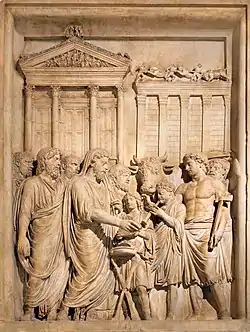 |
| Practices and beliefs |
| Priesthoods |
| Deities |
Deified emperors: |
| Related topics |
Etymology
The name Flōra descends from Proto-Italic *flōsā ('goddess of flowers'), itself a derivation from Proto-Italic *flōs ('flower'; cf. Latin flōs, flōris 'blossom, flower').[4] It is cognate with the Oscan goddess of flowers Fluusa, demonstrating that the cult was known more widely among Italic peoples. The name ultimately derives from Proto-Indo-European *bʰleh₃ōs ('blossoming').[4]
Festival
Her festival, the Floralia, was held between April 28 and May 3 and symbolized the renewal of the cycle of life, drinking, and flowers.[5] The festival was first instituted in 240 B.C.E, and on the advice of the Sibylline books, she was also given a temple in 238 B.C.E. At the festival, with the men decked in flowers, and the women wearing normally forbidden gay costumes, five days of farces and mimes were enacted – ithyphallic,[6] and including nudity when called for[7] – followed by a sixth day of the hunting of goats and hares.[8] On May 23 another (rose) festival was held in her honor.[5]
Flora's Greek equivalent is Chloris, who was a nymph. Flora is married to Favonius, the wind god also known as Zephyr, and her companion was Hercules.
Flora achieved more prominence in the neo-pagan revival of Antiquity among Renaissance humanists than she had ever enjoyed in ancient Rome.
Music
Flora is the main character of the ballet The Awakening of Flora. She is also mentioned in Henry Purcell's Nymphs and Shepherds.
Sculpture
There are many monuments of Flora, e.g. in Capitoline Museums in Rome (Italy), in Valencia (Spain) and Szczecin (Poland) (see Statue of Flora in Szczecin).
In art
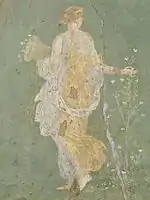
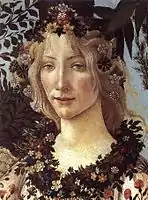 Detail of Flora from Primavera by Botticelli, c. 1482
Detail of Flora from Primavera by Botticelli, c. 1482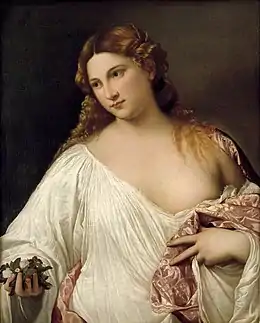 Flora by Titian, 1515
Flora by Titian, 1515 Idealized Portrait of a Courtesan as Flora by Bartolomeo Veneto, c. 1520
Idealized Portrait of a Courtesan as Flora by Bartolomeo Veneto, c. 1520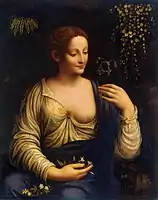 Flora by Francesco Melzi, c. 1520
Flora by Francesco Melzi, c. 1520 Flora and Zephyr, by Jan Brueghel the Elder and Peter Paul Rubens, 1617
Flora and Zephyr, by Jan Brueghel the Elder and Peter Paul Rubens, 1617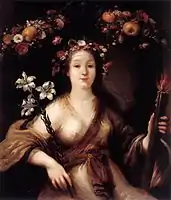 Flora by Claude Vignon, 1650
Flora by Claude Vignon, 1650 Flora by Rembrandt, 1654
Flora by Rembrandt, 1654.jpg.webp) Flora or Hebe by Alexander Roslin, 18th century
Flora or Hebe by Alexander Roslin, 18th century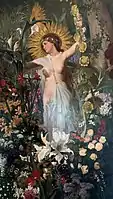 Flora by Valentine Walter Bromley, 1874
Flora by Valentine Walter Bromley, 1874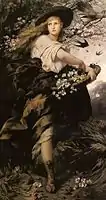 Flora by Ferdinand Keller, 1883
Flora by Ferdinand Keller, 1883 Flora by Mosè Bianchi 1890
Flora by Mosè Bianchi 1890
See also
References
- "Flora". Myth Index. Archived from the original on 2016-05-03.
- "Khloris, goddess of flowers". Theoi Project.
- H. Nettleship ed., A Dictionary of Classical Antiquities (1891) p. 238
- de Vaan 2008, pp. 227–228.
- Guirand, Felix; Aldington, Richard; Ames, Delano; Graves, Robert (December 16, 1987). New Larousse Encyclopedia of Mythology. Crescent Books. p. 201. ISBN 0517004046.
- P/ Green ed., Juvenal: The Sixteen Satires (1982) p. 156
- H. J. Rose, A Handbook of Latin Literature (1967) p. 151
- H. Nettleship ed., A Dictionary of Classical Antiquities (1891) p. 238
Bibliography
- de Vaan, Michiel (2008). Etymological Dictionary of Latin and the other Italic Languages. Brill. ISBN 9789004167971.
Primary
- Ovid, Fasti V.193-212
- Macrobius, Saturnalia I.10.11-14
- Lactantius, Divinae institutions I.20.6-10
External links
 Media related to Flora (dea) at Wikimedia Commons
Media related to Flora (dea) at Wikimedia Commons- . . 1914.
- . Encyclopædia Britannica (11th ed.). 1911.
- The Obscure Goddess Online Directory: Flora
